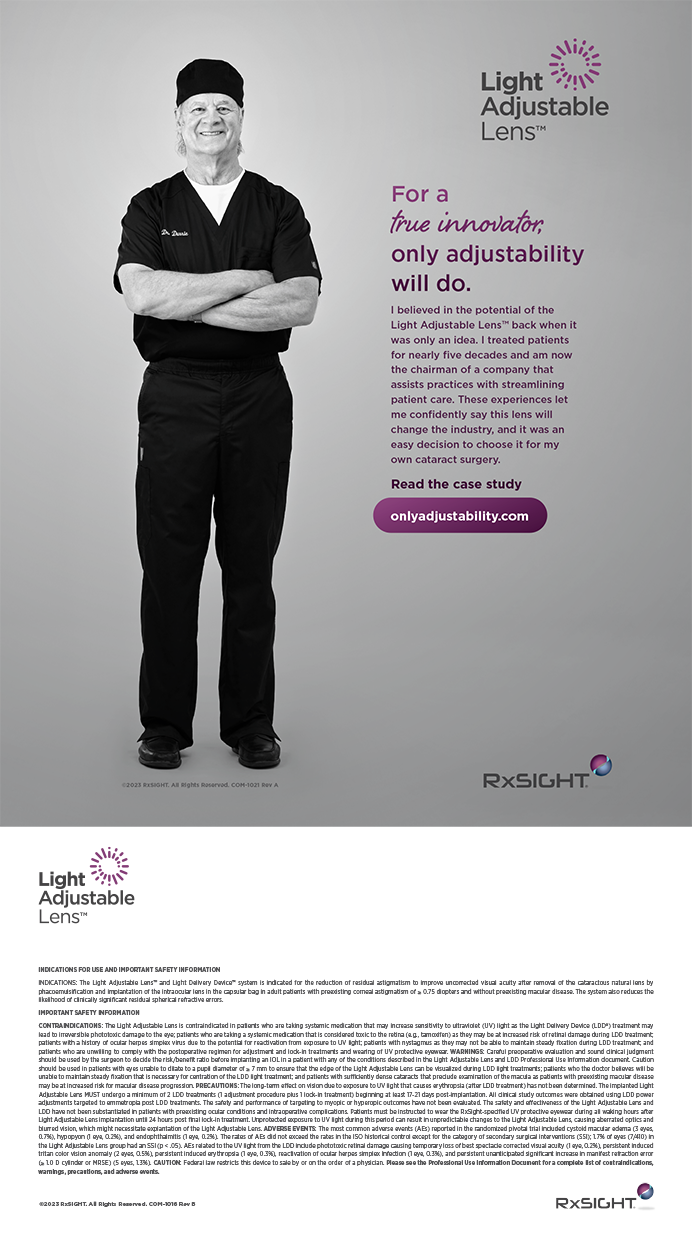Refractive lens exchange is an excellent option for many individuals seeking independence from spectacles and contact lenses. When outcomes require further surgical intervention, however, clear communication provides essential support to patients.
CASE PRESENTATION
A 48-year-old female presented for a screening for refractive surgery. The patient's stated hobbies were gardening and quilting, and she expressed a desire for independence from bifocals and contact lenses. Her refraction was -8.50 2.50 X108 = 20/30 OD and -7.00 1.25 X90 = 20/20 OS. Her axial length measured 26.66 mm OD and 26.35 mm OS, and her pachymetry measurements were 521 ?m OD and 534 ?m OS. Keratometry readings were 43.04 X44.88 @ 85 OD and 43.60 X45.24 @ 67 OS.
The patient stated that her right eye had been mildly amblyopic her entire life. The remainder of the examination was remarkable only for complete posterior vitreous detachments bilaterally. A careful examination of the peripheral retina demonstrated that there were no lesions predisposing her to retinal detachment.
The refractive options for this patient included LASIK, phakic refractive lenses, and refractive lens exchange with an accommodating or multifocal IOL. The primary limitation of LASIK would have been worsening presbyopia or decreased stereopsis due to monovision, and the implantation of the Visian ICL (STAAR Surgical Company, Monrovia, CA) would not have offered any significant advantages over LASIK. Refractive lens exchange combined with limbal relaxing incisions (LRIs) had the potential to treat the patient's myopia, astigmatism, and presbyopia. I discussed the data from the FDA-monitored clinical investigations of the various IOLs with her, including the percentage of patients who achieved spectacle independence and the potential for dysphotopsia. I also explained the possibility of an enhancement procedure (LASIK or a piggyback IOL) to correct residual refractive error. I described her chance of needing an enhancement by reviewing data from my practice. Finally, I thoroughly explained the risks of refractive surgery in general and refractive lens exchange in particular, with special attention to the risk of retinal detachment following lens surgery in highly myopic eyes.
SURGICAL COURSE
Given the patient's desire to be free of glasses and contact lenses for quilting and gardening, which are intermediate-range visual activities, I selected the Crystalens (Bausch & Lomb, Rochester, NY). Her corneal topography demonstrated significant astigmatism, which required correction with LRIs (Figure 1). I cut the LRIs to 90 depth at the 10-mm zone based on the Nichamin nomogram (the minimum pachymetry measurements at this zone were 682 ?m OD and 731 ?m OS). Performed as next-day procedures, the surgeries were uncomplicated.
OUTCOME
One day after surgery, the patient's UCVA measured 20/30 OD and 20/20 and J7 OS (near vision in her right eye was not measured at this visit). She developed regression of her astigmatism by 2 weeks, however, that left her with UCVAs of 20/80 OD and 20/60 OS. Her manifest refraction was -1.25 1.50 X97 = 20/20 OD and -0.25 1.00 X77 = 20/20 OS.
I discussed with the patient her probable need for a LASIK enhancement following stabilization of her refractive state. She required temporary spectacle correction for driving. Although initially moderately disappointed, the patient regained a positive outlook after a thorough explanation of her situation.
At the 6-week postoperative visit, however, she was upset again. The patient's BCVA had declined, and a slit-lamp examination revealed anterior capsular phimosis with a thickened, fibrotic rim of capsule within the pupil in both eyes (Figure 2). There were no other findings to explain the loss of BCVA she had experienced. Anterior segment optical coherence tomography demonstrated the phimotic ridge in both eyes (Figure 3).
After helping the patient regain her calm by explaining what had happened, I took her to the YAG laser and gently dissected the thickened fibrotic rim from the capsular margin. It curled and peeled away, looking something like pieces of a churro dusted with powdered sugar. Three or four of these peelings floated in the anterior chamber and gradually settled into the angle, where they had dissolved by the time of her next examination.
A subsequent slit-lamp examination showed the complete resolution of the phimosis (Figure 4). Anterior segment optical coherence tomography demonstrated that the IOL had shifted position in both eyes (but in opposite directions), and refraction demonstrated the expected changes due to this movement. Her BCVA had improved to 20/20 OU: -0.75 1.25 X92 = 20/20 (SEQ after YAG: -0.125 D, before YAG: Plano) OD -0.50 1.75 X80 = 20/20 (SEQ after YAG: 0.375 D, before YAG: 0.125 D) OS.
Two weeks later, the patient's refraction remained unchanged, and topography demonstrated her recurrent corneal astigmatism (Figure 5). I performed bilateral LASIK, and her uncorrected distance acuity stabilized at 20/25 OD and 20/20 OS. The patient gained two lines of BCVA in her "amblyopic" eye (not unusual with the correction of high myopia) for 20/25 and J10 at near in her right eye and 20/20 and J10 at near in her left eye. Her manifest refraction was 0.50 0.25 X75 = 20/20 OD and 0.25 0.50 X75 = 20/20 OS.
CONCLUSION
The patient was happy that she could garden and quilt without spectacles or contact lenses. She did need reading glasses, however, when using a computer and reading. Ultimately, the regression of her astigmatism was likely related to her relatively thick peripheral corneas. YAG photolysis effectively treated the capsular phimosis, and LASIK provided a spectacular solution of her residual refractive error.
This case demonstrates the necessity of perseverance by the surgeon and the patient in the face of treatable complications of refractive lens exchange.
Mark Packer, MD, is Clinical Associate Professor of Ophthalmology at the Casey Eye Institute, Oregon Health & Science University, and he is in private practice at Drs. Fine, Hoffman, & Packer in Eugene, Oregon. He is a consultant to and has received research funding from Advanced Medical Optics, Inc., and he is a consultant to Bausch & Lomb and Carl Zeiss Meditec, Inc. Dr. Packer may be reached at (541) 687-2110; mpacker@finemd.com.


